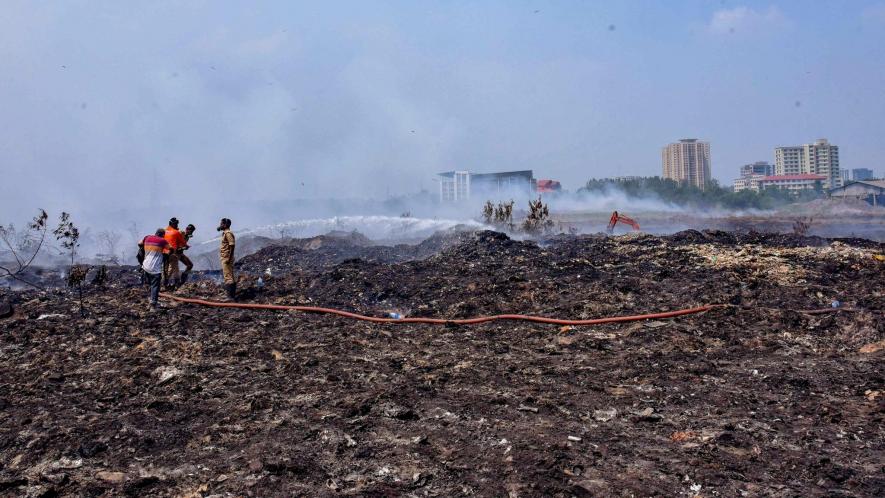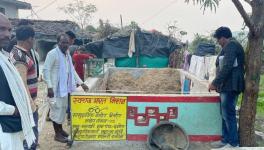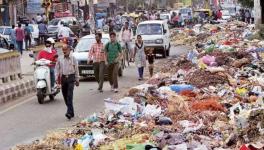Kochi can Overcome Crisis by Adopting Decentralised Waste Management and Segregation at Source

The fire which broke out in the Brahmapuram plant of Kochi corporation was totally controlled after 12 days on March 13. (Image: Dr T M Thomas Isaac/facebook)
The fire in the Brahmapuram Waste Processing Plant, owned and operated by the Kochi Corporation, was put off after 12 days on March 13.
The fire created panic among the residents as toxic smoke engulfed the city and surrounding areas for nearly two weeks. The fire and rescue personnel, Indian Navy and Airforce, besides civil defence volunteers, police and health department officials, were pressed to service.
What made the situation worse in the Brahmapuram plant and the modalities followed are put to introspection now. However, 29 other waste management plants are operated by different local bodies in the state without any such incidents of firing.
The centralised waste management process, contrary to the decentralised processing adopted in other plants and the withdrawal of ‘Processing Waste at Source’ since 2011, is cited as a primary reason for the massive fire breakout, leading to widespread discontent across the IT hub of the state.
Though the fire at the plant is doused, the deliberations over waste management in the city have taken centre stage; the corporation and the state government are contemplating a permanent solution.
CENTRALISED PROCESSING OF WASTE
Brahmapuram, the 110 acres of land 16 km away from the city, became the landfill for Kochi Corporation in 2007. Waste from the corporation and Kochi Corporation, the Kalamassery, Aluva, Angamali, Thrikkakara, Thripunithara municipalities and the Cheranallur, Vadavukod Puthenkurish panchayats were dumped in the plant. All sorts of waste, including food and plastics, have been dumped since then.
While other dump yards in the state adopted decentralised waste management, the Kochi corporation shifted to centralised waste processing after a brief stint of the former.
Dr Thomas Isaac, former finance minister of Kerala, pointed out the shift to centralised waste management and withdrawal of waste segregation in a detailed post he wrote on his Facebook account.
“All dump yards in the state have loads of waste piled up. But other dump yards have not witnessed the crisis encountered by the Brahmapuram plant. Removal of legacy waste is also happening in other plants, but minimal here,” he wrote.
The dump yard in Kollam corporation has been a successful model of segregation and removal of legacy waste, while Alappuzha corporation has encouraged processing at the source.
“Due to different scales of decentralised waste management, there has been no waste movement to the legacy waste plants during the last 5-10 years. The decentralised management was dropped in Kochi as soon as it was started,” Isaac said.
WHO IS TO BE BLAMED?
The Kochi Corporation is presently ruled by the left democratic front (LDF), leading to allegations against the LDF mayor and administration.
But the allegations are levelled without considering the fact that the united democratic front (UDF) led the corporation for 10 years between 2010-2022.
The corporation had signed an agreement in 2012 with Bharat Traders, a private firm, to sell plastics dumped in the plant. But the non-recyclable plastics are not sold and remain dumped in the landfill. The fire allegedly broke out from the plastic segregation section.
Despite several demands, the administration did not consider decentralised waste management, considering the proposed construction of the ‘Waste to Energy’ plant, which is yet to materialise. Though the agreement was signed in 2015, the plan was aborted in 2020.
“People believed that the waste management at source will affect the supply of the waste to energy plant. This was nothing but an illusion leading to the present crisis,” Isaac said.
The three major works in the plant, bio-mining of legacy waste, windrow composting of daily waste collected and plastic waste segregation, are far from satisfactory as the tenders have repeatedly come under the scanner.
In a statement, the Mayor of Kochi Corporation, M Anil Kumar, has demanded a detailed enquiry on all tenders and transactions regarding the Brahmapuram dump yard plant.
WAY FORWARD
Even as the fire outbreak caused much outrage, including breathing issues faced by the residents and air and water pollution, the state government instructed the residents to wear N95 masks to protect themselves from the toxic gas and announced holidays for schools.
The health department has announced a health survey in the city and surrounding villages to detect the possible impact of the pollution.
Though much hue and cry were raised about the air quality in the city, the air quality stood between 157 and 150 between February 28 and March 13, as per the National Air Quality Index.
The successful waste management models in Alappuzha and Kunnamangalam are cited as the solution for the impending problem of Kochi.
“Alappuzha is the first municipality in the state to implement decentralised waste management. For almost a decade, no waste has been transported to the dump yard in Sarvodhayapuram. Instead, the waste is processed at houses, neighbourhood or aerobic centres,” Isaac noted.
Even though only 15 of the 52 wards have become entirely free of waste disposal, there has been a meaningful change in the waste management process.
The Kunnamkulam municipality has successfully ensured waste management without any hiccups since the commencement of the plant in 2016. The plant was constructed in consultation with the Integrated Rural Technology Centre (IRTC) of the Kerala Sastra Sahitya Parishad (KSSP). The plant processes organic, poultry and plastic waste with the active participation of self-help groups.
“Alappuzha learned from Kunnamkulam and Guruvayoor municipalities,” Isaac mentioned.
“The process of Waste management at source is the only possible solution. Dumping waste at the Brahmapuram plant has to stop forever,” he wrote.
The KSSP, the science movement in Kerala, has also called for waste segregation and proper waste processing procedures, citing the Kunnamkulam plant. The organisation has also called for removing the legacy waste from Brahmapuram as the temporary solution for the crisis.
Get the latest reports & analysis with people's perspective on Protests, movements & deep analytical videos, discussions of the current affairs in your Telegram app. Subscribe to NewsClick's Telegram channel & get Real-Time updates on stories, as they get published on our website.
























